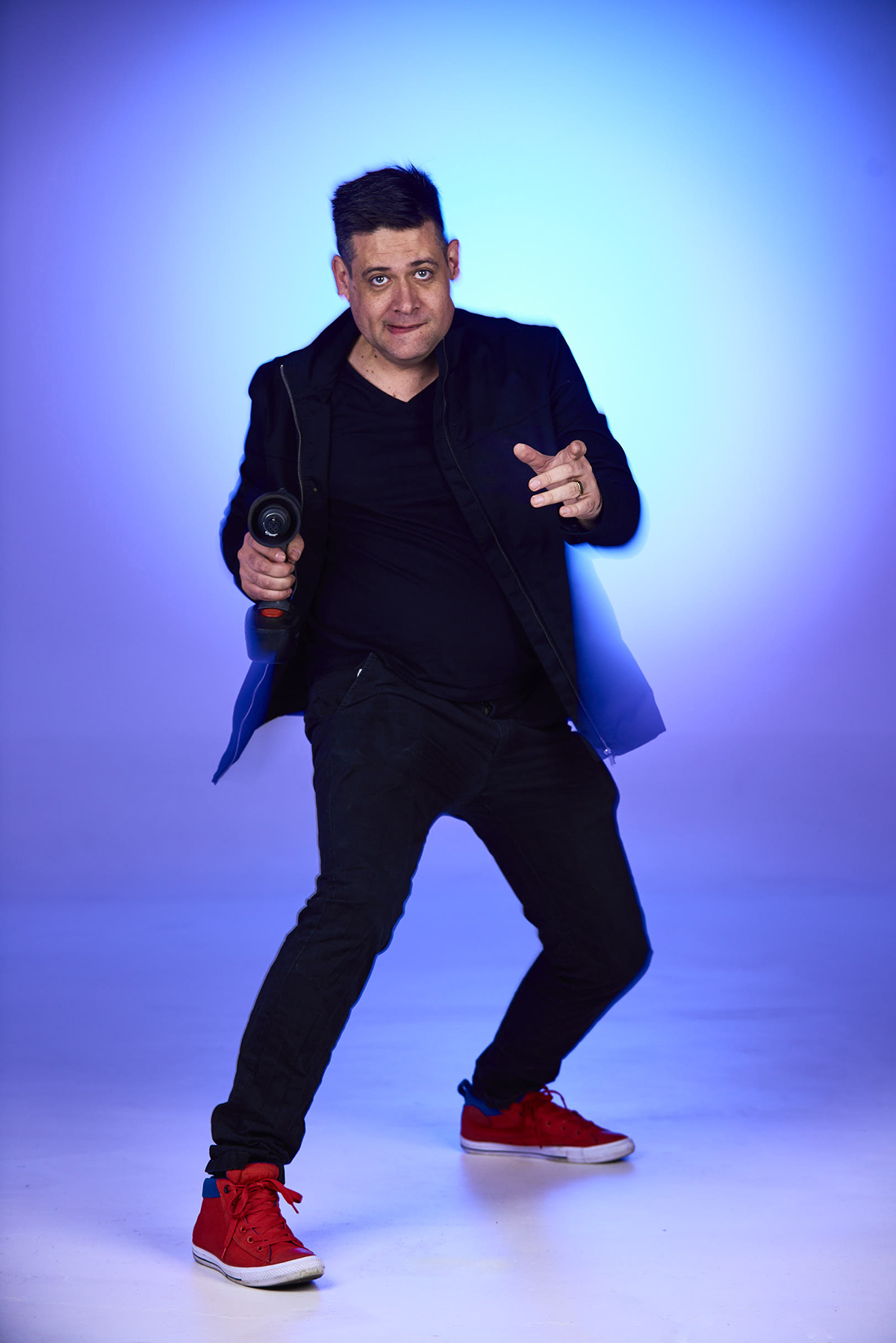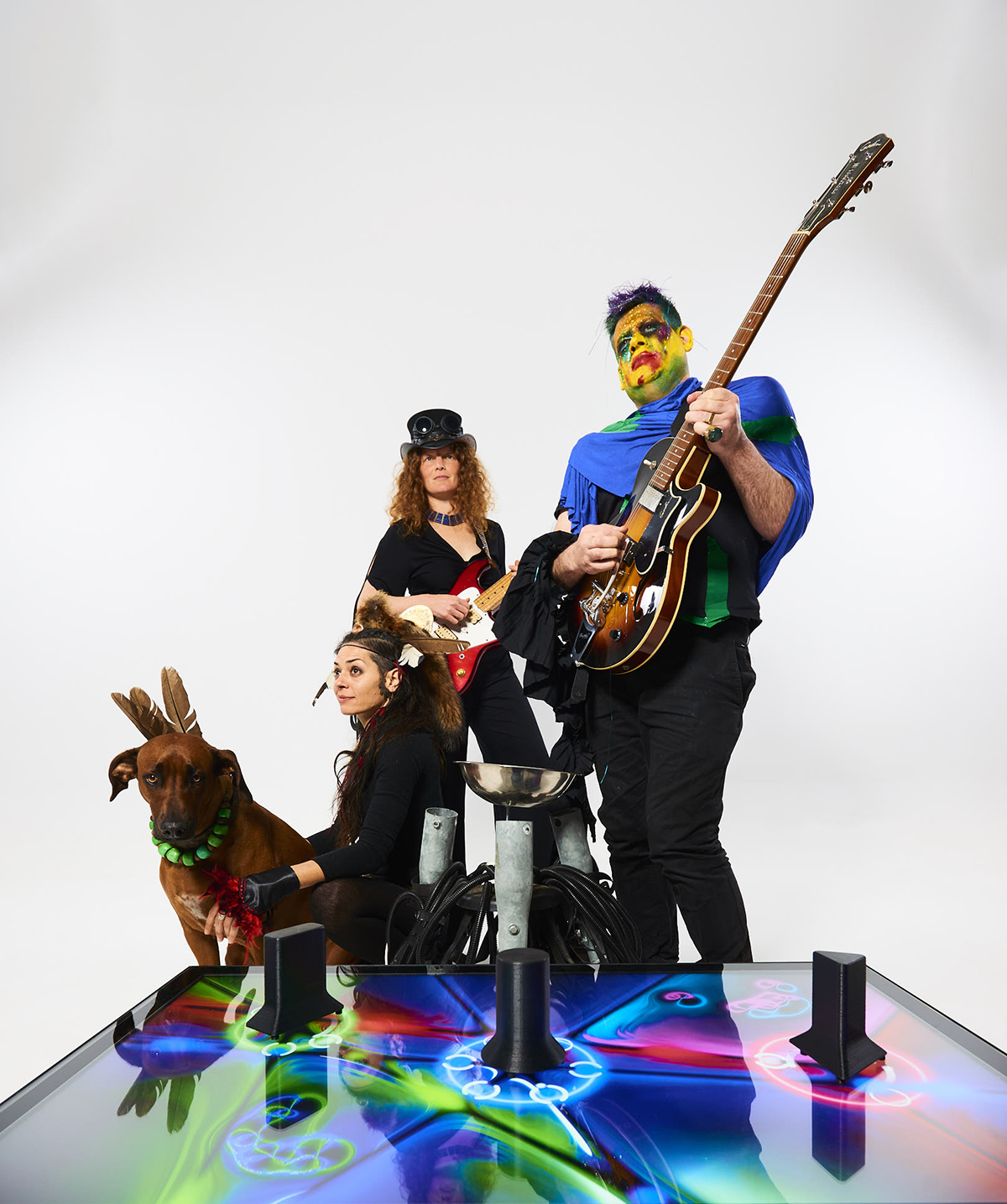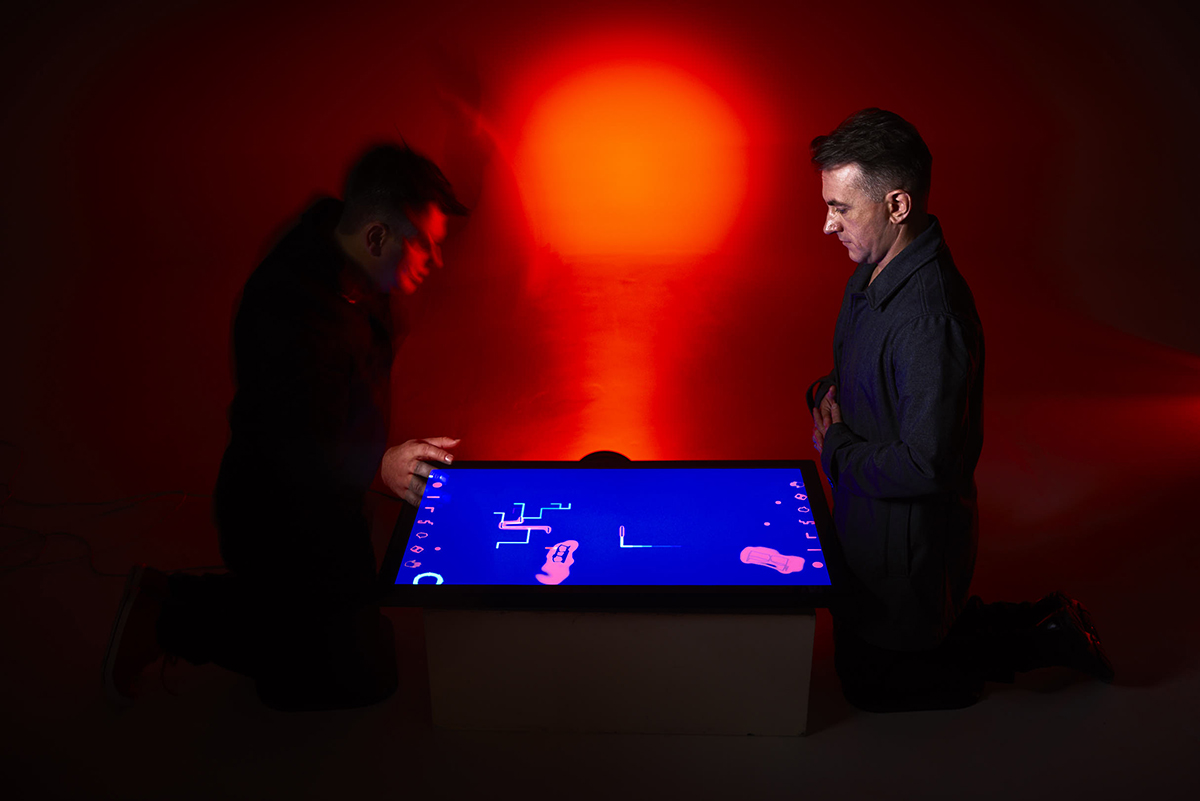
James Hullick: Sound artists just gotta have fun
JOLT are offering readers of RealTime two tickets to City-Topias for the price of one. Simply email: charlotte.bolcskey@joltarts.org with your full name and the code “We love sound!” and what date you would like to book for, to redeem.
–
With concerts titled City-Topias and Disruptive Critters, Melbourne’s JOLT is about to deliver a substantial dose of excitement to the forthcoming Melbourne Music Week. I had a taste of it when JOLT Artistic Director James Hullick recently performed his new work Were/Oblivion on electric guitar with the Sydney Symphony Orchestra in its Dream Sequence concert, drawing on the Jimi Hendrix legacy to unleash a powerful instrumental and vocal epistle to daughters Astrid and Scarlet.
For Were/Oblivion Hullick’s visage was painted with bright colours and a touch of glitter and will be again for City-Topias in which he figures as one of the god-like presences visiting Earth in the concert’s fantastical scenario. Were/Oblivion is one part of City-Topias, an 80-minute audio-visual spectacle promoted as “a wild sci-fi sound art/acousmatic/chamber music/pop art experience.” It’s an unusual claim to make for a work even in the rapidly morphing contemporary classical field, but Hullick is emphatic, he wants sound artists, and audiences, to have fun — seriously realised fun. His use of “sound artists” to cover a range of practitioners, composers and players reveals an integrative vision and reflects the functioning of the musical organisation he heads.
JOLT is a production house that presents performances by the BOLT Ensemble (contemporary music, often with a technological dimension), The Amplified Elephants (a sound art ensemble featuring performers with Down Syndrome), Noise Scavengers (a group of young sound art and experimental music makers) and James Hullick himself. JOLT has staged performances in the UK, Europe and Asia and in Melbourne in 2016 an ambitious three-day event, The Book of Daughters, celebrating International Women’s Day and inspired in part by Hullick’s concerns and hopes for his two daughters.
I spoke with Hullick by phone about this year’s event in which he and Jonathan Duckworth will perform at 7pm on 17 and 18 November in Disruptive Critters and then join the BOLT Ensemble and special guest, the VJ Milica ZZAA, for 9pm performances on the same nights.

James Hullick, photo courtesy JOLT Arts
City-Topias
Where did the alien-god that featured in City-Topias come from?
It was sparked by my daughter Astrid, who is nine. She came home from an art class with a statue that she had painted. When I asked who this fabulously glam rock character was she said, “Dadda.” I laughed of course, because one’s mind tends to gravitate to the flaws in oneself rather than the positives. But I thought about it later, and about her seeing the best in me, and how kind that was of her. I thought, “Wouldn’t it be a loving gift if I could give her that — to be philosophically realised in this way — like the god in this sculpture?” My personal growth — through Astrid’s insight and encouragement — has been significant since that little sculpture came home. And the art has become much richer.
I’m one of the aspects of that entity but another is the BOLT Ensemble themselves and Milica ZZAA who is the VJ for the show. These god-like characters, though they’re not necessarily enlightened, come to communicate with the humans about various facts of life. One of the influences is David Bowie’s Ziggy Stardust and the culture of bringing performance art to pop culture and, in City-Topias, to sound art and seeing how they can co-exist in entertaining and, hopefully, enlightening ways.

Promotional image, City-Topias, photo courtesy JOLT Arts
What instruments will you be playing and in what way god-like?
Electric guitar and keyboards. There are other machines. This god character I’ve been building doesn’t necessarily operate in human ways. The show’s designed so that things manifest rather than being consciously or deliberately delivered, which plays out, for example, in the scores, which are graphic; that hands a lot of interpretation and creativity over to the players. There’s an emphasis on spontaneity, though there is some notation so it’s quite clear what needs to happen at each point in time — an interesting balance with the moments of freedom. [This corresponds with] the god-like characters who have to work out ways of making themselves comprehensible to human beings who just don’t get it.
The visual artist Milica ZZAA is collaborating with you. How will her VJ-ing contribute?
She’s always the smartest person in the room. At one point she said, “Well, if these gods were trying to communicate with humans they’d probably have to use the languages of symbols and sounds because words are too slow for them and humans can interpret a lot of artistic symbols and sounds much more quickly than they can words.” I thought that was actually a lovely thought about the value of art to culture.
A lot of imagery will be galactic as well as from nature, elements of the performers themselves, projected live, words from the songs in the show and my graphic scores.
How is City-Topias structured?
There are four sections. The god is saying, “You’ve got these options for how you can live. There’s Dystopia, Utopia, Heterotopia and Ecotopia, each commented on in song. Were/Oblivion, which I performed in Sydney, is in Dystopia. About Utopia he basically says, “it’s going to require you to simplify and detach yourself from your material possessions, but you can’t do that, so you need to find something else!” (LAUGHS). This god does not have a polite button. He just carries on. It’s up to you to decide what you’re going to do. In the end, he’s saying to the humans, “Maybe the best you can hope for is some kind of Ecotopia where you’re attached to nature and somehow melding your cities more with nature.” And this is happening. There’s a beautiful building in Sydney covered in vines. Urban design is really changing along those lines.
What duration is the work?
About an hour and 20 minutes. It’s become bigger and the reason is that it’s sort of writing itself. We’ve been rehearsing and engaging and adding new thoughts and moments. It’s been lovely to see it develop organically which is not easy in the current arts-funding environment.
As well as an eight-piece chamber ensemble, vocals, guitar and prepared piano, video projection, there’s a Resonance Table. I saw the Amplified Elephants perform with the table at the Bendigo International Festival of Exploratory Music (BIFEM) in 2015. It’s quite magical. How have you integrated this and other machines in the work?
The Resonance Table is basically a large, horizontal touch-screen, hand-made by Jonathan Duckworth who has been making the interfaces with RMIT. You place objects on the table which can read them and as you move the objects around you change the sound. It’s spatialised with surround sound and features in two scenes in City-Topias. There’s another sound machine in one scene, the Gotholin: a robotic violin that plays in grungy industrial and simple ways; it doesn’t sound like a violin at all. And we have the “whirling dervishes” — literally, re-purposed power tools with spinning bowls on each end. The idea with these devices is that the gods are manifesting material things at will. If something pops into their heads, then it’s there.
Would you say City-Topias is fundamentally optimistic?
There’s optimism mixed with a bit of annoyance. The solutions are there; so what’s the problem?

James Hullick, Jonathan Duckworth at the Resonance Table, photo courtesy JOLT Arts
Disruptive Critters
These gods are disruptive; are they companions to the Disruptive Critters in your second program?
The whole point about City-Topias and Disruptive Critters — and this is something I’d like to emphasise — is my feeling that sound artists just aren’t having enough fun. So the work is playful and still highly skilful and refined in, say, the way the technology is used and the techniques involved. That’s a magical combination that doesn’t often happen in sound art, to be brutally honest. It’s difficult to get all those elements together and it costs money. Sound artists generally don’t have a lot of money to spend on their shows. So the bottom line was why not have fun and at the same time include some hard-core kind of philosophical enquiry within the humour? I love stand-up comedy; there’s not nearly enough of it in sound art!
Disruptive Critters has ended up being like the prequel to City-Topias. It’s like a creation myth that plays out in hilarious ways. Jonathan Duckworth and I are onstage characters who play the Resonance Table, which looks like it has the same interface but runs a different program — Disruptive Critters — which has little avatars and creatures running around that we can control. It’s very simply designed and it’s as if we’re playing with the building blocks of life. There’s a subtext in the form of an emergent female child, voiced by my daughter Astrid. It becomes apparent that she hasn’t emerged out of our Disruptive Critters, it’s the other way around — she made us; she is the elemental force. So we end up as the Disruptive Critters because we’re fools. Initially I was a bit concerned about how these shows would speak to each other. We really didn’t know at the start but it ended up emerging quite effortlessly. I think that’s a really important point about this whole project. It’s not the product of a rational, corporate plan. LAUGHS. I think our audiences will feel like they’ve had a real experience, in the Jimi Hendrix sense of the word.
City-Topias was commissioned by APRA Australian Music Centre Art Music Fund; Were/Oblivion by the Sydney Symphony Orchestra. Read more about JOLT here.
–
Melbourne Music Week: JOLT : City-Topias, artists James Hullick, The BOLT Ensemble, VJ Milica ZZAA, Jonathan Duckworth, Meat Market, 9pm, 17, 18 Nov; Disruptive Critters, artists Duckworth Hullick Duo, Meat Market, Melbourne, 7pm, 17, 18 Nov
Top image credit: Dadda doll, Astrid Hullick, photo courtesy the artist






